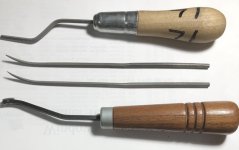The S1 Dembart is a very short length single line cutter. It's best use is for pointing up the diamonds on the very short lines (crowded spaces) like when you get into the corners on point patterns.
It will be useful on pistol grip patterns like the S&W where lines are short.
Most common work around is done with a 90* tool.
Most European and a lot of earlier US work was cut with a 60* diamond point.
Most work is 'pointed up' (sharp) until you get into the coarser LPI checkering. Some 18lpi,, mostly 16lpi below. Then most US work was left flat topped so as not to leave the work cut so deeply to achieve the sharp diamond tops.
Looks better and took less time as well.
If you get into other checkering work, larger patterns,,a long edge single edge/point tool is needed to keep lines straight and sometimes to straighten out a line.
A single line cutter can be very useful for recutting checkering and sometimes is the only tool you can use as old patterns cut with old tools don't always follow perfectly with modern 20, 22, 24, ect LPI cutters.
You can check the LPI (Lines per Inch) of the existing checkering and decide it to be say 20 LPI.
Then start in recutting it with your brand new 20LPI double line/spacer cutter.
After a couple passes you may find that you are starting to cut the old diamond instead of the old valley.
That's becasue the orig pattern isn't exactly 20LPI,,,might be off by a few .000 per line.
It only takes maybe .002 per line and by the time you have cut/spaced over 5 lines you are .010" off,,,,10 lines in you are .020" off and shreading the pattern to pieces.
A single line tool will avoid that, but you will not have the absolute symetry of the diamond pattern overall when done as if you used a spacer tool.
You are following old work,,and as much as we would like to bow at the alter of the old masters,,they made mistakes too and with a single line tool you will follow those old mistakes as well unless you take real pains to correct them.
Old checkering is filled very often with dirt, oil, grease, ect. It's very hard on the checkering tools,,they wear out quickly doing Re-Cut work.
One recut job on old wood can eat up a new cutter head very easily,,usualy two.
The Dembart 'file teeth' type cutters are the choice of a lot of checkerers as they cut smoothly. But the fine teeth dull very quickly and no way to sharpen them.
The larger saw teeth style cutters like GunLine last longer and can be sharpened a couple times, but beyond that you start to change the LPI of the cutter if you get too agressive with sharpening.
They too are just carbon steel and case hardened as the Dembart tool heads are so you can't do a lot with them.
Used checkering tools ,,the actual cutters,,I'd just figure that they were dull.
Unless they were NIB,,never used,,I may buy one for the handle that's attached to it, but that's all unless I could actually examine it.
Carbide checkering tools are available,,not cheap though.
Mostly single line tools. They last a long time.
I have single line carbide in a couple different lengths that I have had and used for 35 yrs or more. The one shorter single line is just starting to be noticably duller than the one that I haven't hardly used. But still more than workable. I use them all the time.
No spacer Carbide at least when I got these, but I think there is an adj single edge spacer carbide tool now. So you adj the spacer to the LPI you want to cut and use the same tool for every LPI by just adj the spacer on it.
Checkering handle(s) will last you forever if not abused. I have Gunline and Dembart. I use the GunLine the most (if that's the one w/the set screw adj up front to adj the angle of the head)
and use both the different cutters on the same handle.
I just use the small finish nail included with the Dembarts for attachment,,clip it off short. Then tighten the opposing set screws on the end of the handle to hold the cutter head secure. Change out is quick and easy.
If you don't use Carbide, you'll need cutter heads. They do wear out even when doing new work.
Checkering tools/cutter heads are getting very tough to find lately and very expensive as well.
Then there's the electric checkering machines.
MMC was one of the originals. There's others now.
Great time savers,, there is a learning curve! and they are not cheap either.
I use an MMC I've ad since the 70's to rough out the pattern then finish it up with the hand tools.
Probably cuts the over all checkering time by at least 1/2,,sometimes 2/3 depending on the job of course.
It's tedious work that I never wanted to really get in to. Kind of fell into it to fill a void at one time for a couple local gunshops 50yrs ago,,and just kept on with it.
Retired now but work on my own projects.



